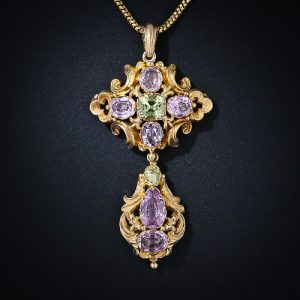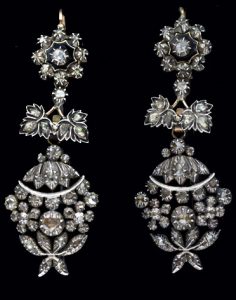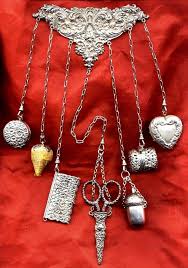The reign of Kings George I, II, III, IV (1714-1837) witnessed a period of change in the social life and culture of England. There was a fascination towards everything exotic. Jewelry in no way could have been an exception to it.
Features of Georgian Jewelry
- Handcrafted and Labour intensive
Skilled craftspersons were required to make this jewelry. they would make thin sheets of the desired metal. Desired stones were then embedded using various techniques. In the case of gemstones, the foil was used for backing. It enhanced sparkling of the stone especially diamonds. However, this sort of jewelry had to be treated with extreme care for contact with water, extreme sunlight could cause damage.
- Melting old jewelry
This new form of ornaments was so sophisticated that many times, old jewelry was melted and reused to suit respective trends. In the process, prior varieties of Georgian era jewelry is lost. It is thus difficult to pinpoint the source of inspiration for the emerging trend.
- Naturalistic Ornate work
The work was extremely ornate with detailing to the fullest. The way stone was to be cut was clearly defined for different purposes. Impact of cutting stone and combination with different metals creating different sort of sparkle, the shine was understood by the craftsmen. Naturalistic motifs of flowers, crescents, ribbons, bows, leaves, feathers, sprays of foliage were observed.
- Metalworking and stone cutting techniques
- Repoussé is a metalworking technique in which a malleable metal is ornamented or shaped by hammering from the reverse side to create a design in low relief. It is a form of toreutics (metal engraving).
- Cannetille is a type of filigree work featuring fine sheets or wires of metal especially gold.
Stones were cut in a variety of ways to create diverse effects.
- Table cut was a square shape with a flat bottom
- Rose cut involved cutting the stone in the round with a domed top and flat bottom
- Old mine cut closely resembling the modern brilliant cut was a rounded square shape with many facets; thus more light being reflected
- Briolette was a teardrop shape
Jewelry Adorned by Women can be Categorized As-
- Neckpieces
These involved the abundant use of gemstones set in choker pattern. Pendant also was in vogue with well-matched pairs of earrings. A strand of gemstones used for the necklace is also seen.
- Earrings
Studs, dangling varieties were favorites. Teardrop shape for the stone and pearl is seen frequently. Pendeloque i.e pear-shaped dangling earrings were a favorite among elite women.
- Bracelets
Bracelets were delicate in nature and mostly worn in pairs. Painted, enameled, gemstone embedded were the famous varieties. At times, bracelets were also woven as a hair accessory.
- Brooch, hairpins, chatelaines
Brooches of number varieties and metals were prepared. Precious metals and stones being common, porcelain was also used in later times. Hairpins of numerous varieties- comb-like, pin, brooch-like are seen. Another kind of ornament was a chatelaine which was a decorative belt to hold tools like scissors, writing instruments, watches etc. This was especially used by men.
- Finger rings
Rings are a feature of this era which changed the idea of finger rings in the years to come. Single stone, banded, ornate and intricate embedding of stones are the kinds which made history. Read more about Georgian rings.
The beauty of Georgian jewelry lies in its utility with elegance. Necklaces were detachable to make pairs of bracelets. A pendant could also act like a brooch. Dangling earrings could be converted into studs. These convertibles are known as Parure which won the hearts of young and old alike.
More Info On- Georgian-Fashion, Victorian Era Designs and Patterns, Victorian Era Gowns


